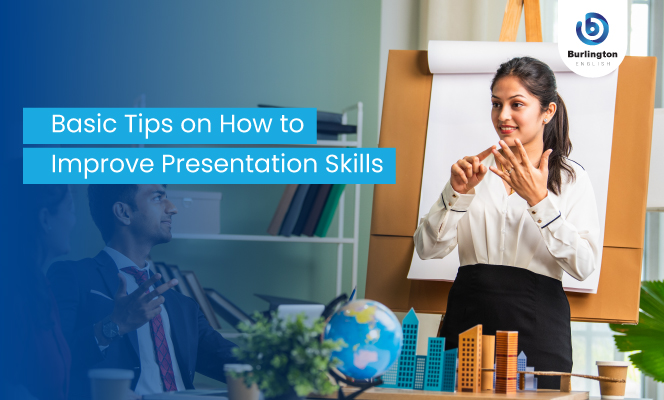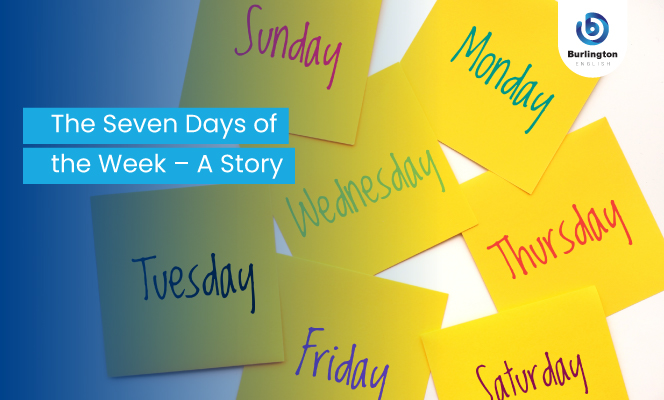How do you feel when you’re asked to deliver a presentation at work/college/university? Are you happy that you’ll have a platform to share your ideas with an audience? Do you think meh, boring? Or does the very idea of speaking in public fill you with fear and dread? Whatever your reaction, this occasional series of Burlington English presentation skills blogs will help you present more confidently and wow your audience! In the first blog of the series, we’ll be looking at some general principles for creating and delivering an amazing presentation in English. And we’ll supply you with some useful words and phrases for structuring your presentation. So, what are you waiting for? Let’s get started!
Take Control!
The most important things to remember when delivering a presentation
- Your content: your words/your slides/the structure of your presentation, etc.
- Your non-verbal communication: your face/your hands and arms/your posture/your movement, etc.
- Your voice: your volume/your pace/your pitch and intonation, etc.
A common mistake here is to focus only on the content – if you really want to knock the audience’s socks off, you need to make sure that your body language and voice are reinforcing your message, and that the overall impression your create is one of confidence and credibility.
The most effective presentation skills
Think About the Audience
Once you’ve selected or been given your topic, think about you audience. What do they know about the topic? What do they need to know? What aspect of your topic do you want them to focus on? What do you want them to do after seeing your presentation?
Timing
You also need to consider the amount of time you have for your presentation, and how you will tailor your content to fit the time limit. For example, imagine your topic is “The Role of Social Media in Marketing” and you have been allocated a 15-minute time slot. It would be impossible to cover such a vast topic in 15 minutes, so you’ll need zero in on a particular aspect of the topic. No one likes a presenter who overruns their time slot, so make sure your timings are bang on .
Practice Makes Perfect
The more you practice your presentation, the more confident you’ll feel! You should know exactly what you’re going to say and how you’re going to say it. Video yourself, then watch your performance with a critical eye – what aspects of your delivery do you like/dislike? Do you like the way your voice sounds? Did you look and sound credible and confident? Is this presentation going to wow your audience? You can also practice in front of a mirror, in front of your family, or in front of your friends and classmates. The delivery will get easier every time.
Ditch the Bullet Points!
Slides and other visuals that are covered in text are dull! Make sure that your visuals are visual ! Many presenters make the mistake of reading out the words on their slides. Not only is this extremely boring, but also, the audience will have read the words before the presenter has finished saying them – because we read more quickly than we speak. If your audience have already read your content before you have said it, they will have no reason to listen to you. And they will stop listening. Next time you design a slide deck, try to avoid words altogether, or use charts and infographics with very little text. Remember – the purpose of your visuals is to support what you say – not say it for you.
Use Signalling Language
If you’re giving a presentation in English, don’t forget to use signalling language. This will help your audience to follow your presentation with ease – which is important if you want them to remember what you’ve said. Here are some examples of signalling language that you could use in your next presentation:
> Giving the aim of the presentation
- Today I’m going to talk about/discuss/present …
- The aim of my presentation today is …
- In this presentation today we’re going to consider/look at/discuss …
> Giving an overview of your talk
- First, we’re going to …
- Next, we’ll …
- Then we’ll …
- Finally, we’ll …
- So that’s our plan/agenda for today’s presentation.
> Beginning the discussion/presentation
- Okay, let’s start by considering/looking at/discussing …
- All right, let me begin by …
- First of all, I’d like to discuss …
- Let’s start today by talking about …
- I’ll begin by …
- I’ll start by …
> Summarizing an idea and/or moving on to the next point
- We’ve discussed/looked at … Now let’s move on to …
- Now that I’ve discussed … I’d like to continue by discussing …
- I’ve told you why … Now I’ll tell you how …
- In addition to … [what you just covered], another important aspect is …
- Let’s go back to …
- Let me turn to the next point …
> Signalling a conclusion
- Those are the major points I wanted to discuss today.
- The take-home message from today’s talk is …
- In brief …
- To summarize …
- To conclude …
- Let me wrap up by saying …
We hope you’ve found our basic tips useful, and that they’ll inspire you to deliver an amazing presentation that’ll blow your audience away ! Look out for our next Presentation Skills blog which will focus on non-verbal communication.
Of course, the best way to improve your presentation skills is to subscribe to an English speaking course. Our spoken English training features expert tutors who will help you to speak English more fluently and feel more confident when speaking in public.







